Pfizer
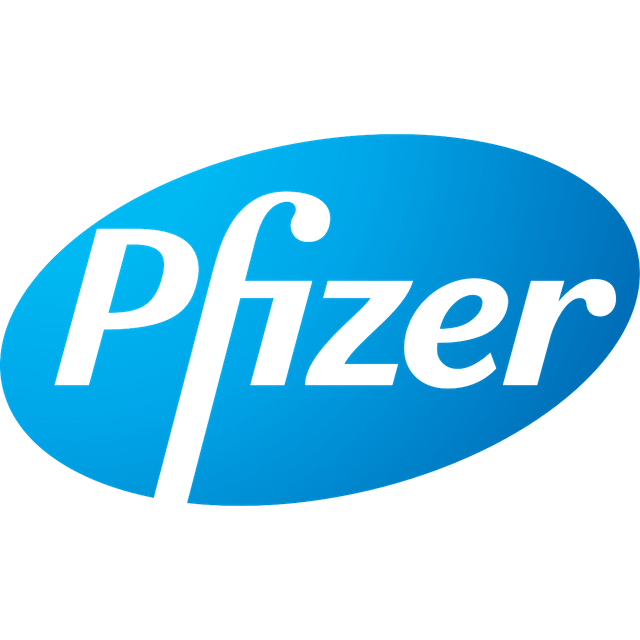
Pfizer

 Entrance to Pfizer headquarters | |
Type | Public |
|---|---|
| Traded as | |
| Industry | Pharmaceutical |
| Founded | 1849 (1849) |
| Founders | Charles Pfizer Charles F. Erhart |
| Headquarters | New York City ,U.S. |
Area served | Worldwide |
Key people | Ian Read (Executive Chairman) Albert Bourla (CEO) |
| Products | See list |
| Revenue | |
Operating income | |
Net income | |
| Total assets | |
| Total equity | |
Number of employees | ~92,400(2018)[1] |
| Subsidiaries | Agouron Pharmaceuticals G.D. Searle, LLC Greenstone Hospira InnoPharma Parke-Davis |
| Website | www.pfizer.com [188] |
Pfizer Inc. (/ˈfaɪzər/)[2] is an American multinational pharmaceutical corporation headquartered in New York City,[3] with its research headquarters in Groton, Connecticut. It is one of the world's largest pharmaceutical companies.[4] It is listed on the New York Stock Exchange, and its shares have been a component of the Dow Jones Industrial Average since 2004.[5] Pfizer ranked No. 57 on the 2018 Fortune 500 list of the largest United States corporations by total revenue.[6]
On December 19, 2018, Pfizer announced a joint merger of their consumer healthcare division with UK pharma giant GlaxoSmithKline; the British company will maintain a controlling share (listed at 68%).[7]
The company develops and produces medicines and vaccines for a wide range of medical disciplines, including immunology, oncology, cardiology, endocrinology, and neurology. Its products include the blockbuster drug Lipitor (atorvastatin), used to lower LDL blood cholesterol; Lyrica (pregabalin) for neuropathic pain and fibromyalgia; Diflucan (fluconazole), an oral antifungal medication; Zithromax (azithromycin), an antibiotic; Viagra (sildenafil) for erectile dysfunction; and Celebrex (also Celebra, celecoxib), an anti-inflammatory drug.
In 2016, Pfizer Inc. was expected to merge with Allergan, Plc to create the Ireland-based "Pfizer plc" in a deal that would have been worth $160 billion.[8] The merger was called off in April 2016, however, because of new rules from the United States Treasury against tax inversions, a method of avoiding taxes by merging with a foreign company.[9] The company has made the second-largest pharmaceutical settlement with the United States Department of Justice.
 Entrance to Pfizer headquarters | |
Type | Public |
|---|---|
| Traded as | |
| Industry | Pharmaceutical |
| Founded | 1849 (1849) |
| Founders | Charles Pfizer Charles F. Erhart |
| Headquarters | New York City ,U.S. |
Area served | Worldwide |
Key people | Ian Read (Executive Chairman) Albert Bourla (CEO) |
| Products | See list |
| Revenue | |
Operating income | |
Net income | |
| Total assets | |
| Total equity | |
Number of employees | ~92,400(2018)[1] |
| Subsidiaries | Agouron Pharmaceuticals G.D. Searle, LLC Greenstone Hospira InnoPharma Parke-Davis |
| Website | www.pfizer.com [188] |
History
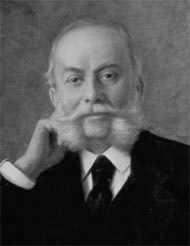
Charles Pfizer
Pfizer was founded in 1849 by German-American Charles Pfizer and his cousin Charles F. Erhart from Ludwigsburg, Germany. They launched the chemicals business Charles Pfizer and Company from a building at the intersection of Harrison Avenue and Bartlett Street[10] in Williamsburg, Brooklyn, where they produced an antiparasitic called santonin. This was an immediate success, although it was the production of citric acid that really kick-started Pfizer's growth in the 1880s. Pfizer continued to buy property to expand its lab and factory on the block bounded by Bartlett Street, Harrison Avenue, Gerry Street, and Flushing Avenue. Pfizer's original administrative headquarters was at 81 Maiden Lane in Manhattan.[10]
By 1906, sales totaled $3.4 million.[11]
World War I caused a shortage of calcium citrate which Pfizer imported from Italy for the manufacture of citric acid, and the company began a search for an alternative supply. Pfizer chemists learned of a fungus that ferments sugar to citric acid, and they were able to commercialize production of citric acid from this source in 1919, and the company developed expertise in fermentation technology as a result. These skills were applied to the mass production of the antibiotic penicillin during World War II in response to the need to treat injured Allied soldiers; most of the penicillin that went ashore with the troops on D-Day was made by Pfizer.[12]
Penicillin became very inexpensive in the 1940s, and Pfizer searched for new antibiotics with greater profit potential. They discovered Terramycin (oxytetracycline) in 1950, and this changed the company from a manufacturer of fine chemicals to a research-based pharmaceutical company. Pfizer developed a drug discovery program focusing on in vitro synthesis in order to augment its research in fermentation technology. The company also established an animal health division in 1959 with an 700-acre (2.8 km2) farm and research facility in Terre Haute, Indiana.
By the 1950s, Pfizer had established offices in Belgium, Brazil, Canada, Cuba, Mexico, Panama, Puerto Rico, and the United Kingdom. In 1960, the company moved its medical research laboratory operations out of New York City to a new facility in Groton, Connecticut. In 1980, they launched Feldene (piroxicam), a prescription anti-inflammatory medication that became Pfizer's first product to reach one billion dollars in total sales.[13] During the 1980s and 1990s, Pfizer Corporation growth was sustained by the discovery and marketing of Zoloft, Lipitor, Norvasc, Zithromax, Aricept, Diflucan, and Viagra.[14][15]
2000–2010
In this decade, Pfizer grew by mergers, including those with Warner–Lambert (2000), Pharmacia (2003), and Wyeth (2009).
In 2003, the company acquired Esperion Therapeutics for $1.3 billion (later selling the unit in 2008), protecting Lipitor from ETC-216.[16] In 2004, Pfizer announced it would acquire Meridica for $125 million.[16] In 2005, the company made a number of acquisitions: Vicuron Pharmaceuticals for $1.9 billion, Idun for just less than $300 million and finally Angiosyn for $527 million.[16]
Development of torcetrapib, a drug that increases production of HDL, or "good cholesterol", which reduces LDL thought to be correlated to heart disease, was cancelled in December 2006. During a Phase III clinical trial involving 15,000 patients, more deaths occurred in the group that took the medicine than expected, and a sixty percent increase in mortality was seen among patients taking the combination of torcetrapib and Lipitor versus Lipitor alone. Lipitor alone was not implicated in the results, but Pfizer lost nearly $1 billion developing the failed drug and the market value of the company plummeted afterwards.[20][21][22] The company also announced it would acquire Powermed and Rivax.
In September 2009, Pfizer pleaded guilty to the illegal marketing of the arthritis drug Bextra for uses unapproved by the U.S. Food and Drug Administration (FDA), and agreed to a $2.3 billion settlement, the largest health care fraud settlement at that time.[23]
A July 2010 article in BusinessWeek reported that Pfizer was seeing more success in its battle against makers of counterfeit prescription drugs by pursuing civil lawsuits rather than criminal prosecution. Pfizer has hired customs and narcotics experts from all over the globe to track down fakes and assemble evidence that can be used to pursue civil suits for trademark infringement. Since 2007, Pfizer has spent $3.3 million on investigations and legal fees and recovered about $5.1 million, with another $5 million tied up in ongoing cases.[24]
On May 6, 2013, Pfizer told The Associated Press it would begin selling Viagra directly to patients via its website.[25]
Warner–Lambert acquisition
Pfizer acquired Warner–Lambert in 2000 for $111.8 billion,[26] at the time, created the second largest pharmaceutical company in the world.[27] Warner–Lambert was founded as a Philadelphia drug store in 1856 by William R. Warner. Inventing a tablet-coating process gained Warner a place in the Smithsonian Institution. Parke–Davis was founded in Detroit in 1866 by Hervey Parke and George Davis. Warner–Lambert took over Parke–Davis in 1976, and acquired Wilkinson Sword in 1993 and Agouron Pharmaceuticals in 1999.
Pharmacia acquisition
In 2002, Pfizer merged with Pharmacia. The merger was again driven in part by the desire to acquire full rights to a product, this time Celebrex (celecoxib), the COX-2 selective inhibitor previously jointly marketed by Searle (acquired by Pharmacia) and Pfizer. In the ensuing years, Pfizer carried out a massive restructuring that resulted in numerous site closures and the loss of jobs including Terre Haute, Indiana; Holland, Michigan; Groton, Connecticut; Brooklyn, New York; Sandwich, UK; and Puerto Rico.
Pharmacia had been formed by a series of mergers and acquisitions from its predecessors, including Searle, Upjohn and SUGEN.
Searle was founded in Omaha, Nebraska, in April 1888. The founder was Gideon Daniel Searle. In 1908, the company was incorporated in Chicago, Illinois. In 1941, the company established headquarters in Skokie, Illinois. It was acquired by the Monsanto Company, headquartered in St. Louis, Missouri, in 1985.
The Upjohn Company was a pharmaceutical manufacturing firm founded in 1886 in Kalamazoo, Michigan, by Dr. William E. Upjohn, an 1875 graduate of the University of Michigan medical school. The company was originally formed to make friable pills, which were specifically designed to be easily digested. Greenstone was founded in 1993 by Upjohn as a generics division.[28] In 1995, Upjohn merged with Pharmacia, to form Pharmacia & Upjohn. Pharmacia was created in April 2000 through the merger of Pharmacia & Upjohn with the Monsanto Company and its G.D. Searle unit. The merged company was based in Peapack, New Jersey. The agricultural division was spun off from Pharmacia, as Monsanto, in preparation for the close of the acquisition by Pfizer.[29]
SUGEN, a company focused on protein kinase inhibitors, was founded in 1991 in Redwood City, California, and acquired by Pharmacia in 1999. The company pioneered the use of ATP-mimetic small molecules to block signal transduction. After the Pfizer merger, the SUGEN site was shut down in 2003, with the loss of over 300 jobs, and several programs were transferred to Pfizer. These included sunitinib (Sutent), which was approved for human use by the FDA in January 2006, passed $1 billion in annual revenues for Pfizer in 2010.[30] A related compound, SU11654 (Toceranib), was also approved for canine tumors, and the ALK inhibitor Crizotinib also grew out of a SUGEN program.[31]
In 2008, Pfizer announced 275 job cuts at the Kalamazoo manufacturing facility. Kalamazoo was previously the world headquarters for the Upjohn Company.[33]
Wyeth acquisition
On January 26, 2009, after more than a year of talks between the two companies, Pfizer agreed to buy pharmaceuticals rival Wyeth for a combined US$68 billion in cash, shares and loans, including some US$22.5 billion lent by five major Wall Street banks. The deal cemented Pfizer's position as the largest pharmaceutical company in the world, with the merged company generating over US$20 billion in cash each year, and was the largest corporate merger since AT&T and BellSouth's US$70 billion deal in March 2006.[34] The combined company was expected to save US$4 billion annually through streamlining; however, as part of the deal, both companies must repatriate billions of dollars in revenue from foreign sources to the United States, which will result in higher tax costs. The acquisition was completed on October 15, 2009, making Wyeth a wholly owned subsidiary of Pfizer.[35]
The merger was broadly criticized. Harvard Business School's Gary Pisano told The Wall Street Journal, "the record of big mergers and acquisitions in Big Pharma has just not been good. There's just been an enormous amount of shareholder wealth destroyed."[36] Analysts said at the time, "The Warner–Lambert and Pharmacia mergers do not appear to have achieved gains for shareholders, so it is unclear who benefits from the Wyeth–Pfizer merger to many critics."[37]
King Pharmaceuticals acquisition
In October 2010, Pfizer agreed to buy King Pharmaceuticals for $3.6 billion in cash or $14.25 per share: an approximately 40% premium over King's closing share price October 11, 2010.[38]
2011–present
In February 2011, it was announced that Pfizer was to close its UK research and development facility (formerly also a manufacturing plant) in Sandwich, Kent, which at the time employed 2,400 people.[39] However, as of 2014, Pfizer has a reduced presence at the site;[40] it also has a UK research unit in Cambridge.[41]
In July 2014, the company announced it would acquire Innopharma for $225 million, plus up to $135 million in milestone payments, in a deal that expanded Pfizer's range of generic and injectable drugs.[43]
On January 5, 2015, the company announced it would acquire a controlling interest in Redvax for an undisclosed sum. This deal expanded the company's vaccine portfolio targeting human cytomegalovirus.[44] In March 2015, the company announced it would restart its collaboration with Eli Lilly surrounding the phase III trial of Tanezumab. Pfizer is expected to receive an upfront sum of $200 million.[45] In June 2015, the company acquired two meningitis drugs from GlaxoSmithKline—Nimenrix and Mencevax—for around $130 million, expanding the company's meningococcal disease portfolio of drugs.[46]
In May 2016, the company announced it would acquire Anacor Pharmaceuticals for $5.2 billion, expanding the companies portfolio in both inflammation and immunology drugs areas.[47] On their final trading day, Anacor shares traded for $99.20 each, giving Anacor a market capitalisation of $4.5 billion. In August, the company made a $40 million bid for the assets of the now bankrupt BIND Therapeutics through the U.S. Bankruptcy Court.[48] The same month, the company announced it would acquire Bamboo Therapeutics for $645 million, expanding the company's gene therapy offerings.[49] Later, in August, the company announced the acquisition of cancer drug-maker - Medivation - for $14 billion.[50][51] On Medivation's final day of trading, its shares were valued at $81.44 each, giving an effective market capitalisation of $13.52 billion. Two days later, Pfizer announced it would acquire AstraZenecas small-molecule antibiotics business for $1.575 billion[52] merging it into its Essential Medicines business[53] In the same month the company licensed the anti-CTLA4 monoclonal antibody, ONC-392, from OncoImmune.[54]
In May 2019 the company announced it would acquire Therachon for $810 million, expanding its rare disease portfolio through Theracons recombinant human fibroblast growth factor receptor 3 compound, aimed at treating conditions such as achondroplasia.[55] In June, Pfizer announced it would acquire Array Biopharma for $10.6 billion boosting its oncology pipeline.[56]
Zoetis
Plans to spin out Zoetis, the Agriculture Division of Pfizer and later Pfizer Animal Health, were announced in 2012. Pfizer filed for registration of a Class A stock with the U.S. Securities and Exchange Commission on August 13, 2012.[57] Zoetis's IPO on February 1, 2013, sold 86.1 million shares for US$2.2 billion.[58] Pfizer retained 414 million Class B shares, giving it an 83% controlling stake in the firm.[59] The offering's lead underwriters were JPMorgan Chase, Bank of America, Merrill Lynch, and Morgan Stanley.[58] Most of the money raised through the IPO was used to pay off existing Pfizer debt.[60]
Attempted AstraZeneca acquisition
In April 2014, it was reported that Pfizer had reignited a $100 billion takeover bid for the UK-based AstraZeneca,[61][62] sparking political controversy in the UK,[63] as well as in the US.[64] On May 19, 2014, a "final offer" of £55 a share was rejected by the AstraZeneca board, which said the bid was too low and imposed too many risks. If successful, the takeover—the biggest in British history—would have made Pfizer the world's largest drug company.[65] Hopes for a renewed bid later in the year were dashed when Pfizer signed a major cancer drug deal with Merck KGaA, selling its sharing rights to develop an experimental immunotherapy drug for a fee of $850 million.[66]
Hospira
In February 2015, Pfizer and Hospira agreed that Pfizer would acquire Hospira for $15.2 billion,[67] a deal in which Hospira shareholders would receive $90 in cash for each share they owned.[68][69] News of the deal sent Hospira share prices up from $63.43 to $87.43 on a volume of 60.7 million shares.[70] Including debt, the deal is valued at around $17 billion.[67] Hospira is the largest producer of generic injectable pharmaceuticals in the world.[71] On the final day of trading, Hospira shares traded for $89.96 each, giving a market capitalisation of $15.56 billion.
Attempted Allergan acquisition
On November 23, 2015, Pfizer and Allergan, Plc announced their intention to merge for an approximate sum of $160 billion, making it the largest pharmaceutical deal ever, and the third largest corporate merger in history. As part of the deal, the Pfizer CEO, Ian Read, was to remain as CEO and chairman of the new company, to be called "Pfizer plc", with Allergan's CEO, Brent Saunders, becoming president and chief operating officer. As part of the deal, Allergan shareholders would receive 11.3 shares of the company, with Pfizer shareholders receiving one. The terms proposed that the merged company would maintain Allergan's Irish domicile, resulting in the new company being subject to corporation tax at the Irish rate of 12.5%--considerably lower than the 35% rate that Pfizer paid at the time.[72] The deal was to constitute a reverse merger, whereby Allergan acquired Pfizer, with the new company then changing its name to "Pfizer, plc".[73][74][75] The deal was expected to be completed in the second half of 2016, subject to certain conditions: US and EU approval, approval from both sets of shareholders, and the completion of Allergan's divestiture of its generics division to Teva Pharmaceuticals (expected in the first quarter of 2016).[73] On April 6, 2016, Pfizer and Allergan announced they would be calling off the merger after the Obama administration introduced new laws intended to limit corporate tax inversions (the extent to which companies could move their headquarters overseas in order to reduce the amount of taxes they pay).[76]
Pfizer re-organisation
In 2018 Pfizer announced it would reorganise its business into three separate units; a higher margin division - Innovative medicines, lower margin off-patent drugs and consumer healthcare, with a view to focussing on higher margin therapies.
Pfizer Consumer Healthcare
In October 2017, reports emerged that Pfizer were undertaking a strategic review of their Consumer Healthcare division, with possible results ranging from a partial or complete spin-off or a direct sale[77] with the divestment expected to raise in the region of $15 billion for one of the largest Over-the-Counter businesses in the world.[78] Reckitt Benckiser expressed interest in bidding for the division earlier in October[79] with Sanofi, Johnson & Johnson, Procter & Gamble[80] and GlaxoSmithKline also being linked with bids for the business.[81] On March 22, Reckitt Benckiser pulled out of the deal, a day later GlaxoSmithKline also pulled out.[82]
In December 2018, GlaxoSmithKline announced that it, along with Pfizer, had reached an agreement to merge and combine their consumer healthcare divisions into a single entity. The combined entity would have sales of around £9.8 billon ($12.7 billion), with GSK maintaining a 68% controlling stake in the joint venture. Pfizer would own the remaining 32% shareholding. The deal builds on an earlier 2018 deal where GSK bought out Novartis' stake in the GSK-Novartis consumer healthcare joint business.[83][84]
Pfizer off-patent drug business
In late July 2019, the company announced that it would spin off and merge its off patent medicine division, Upjohn, with Mylan, forming a brand new pharmaceutical business with sales of around $20 billion.[85] The new combined business will have a portfolio of drugs and brands including the Epi-Pen, Viagra, Lipitor and Celebrex.[86][87]
The deal will be structured as an all-stock, Reverse Morris Trust transaction:
Upjohn will be spun off to Pfizer shareholders and then combined with Mylan
Each share of Mylan’s stock will be converted into one share of the new company
Pfizer shareholders would own 57% of the combined new company and Mylan shareholders will own 43%
Acquisition history
Operations
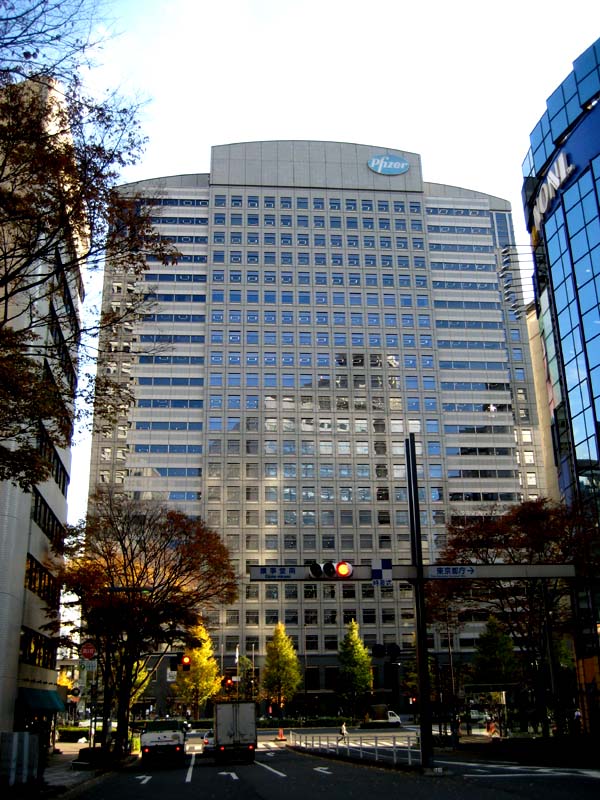
The headquarters of Pfizer Japan in Tokyo
Pfizer is organised into nine principal operating divisions: Primary Care, Specialty Care, Oncology, Emerging Markets, Established Products, Consumer Healthcare, Nutrition, Animal Health, and Capsugel.[88]
Partnerships
In May 2015, Pfizer and a Bar-Ilan University laboratory announced a partnership based on the development of medical DNA nanotechnology.[89]
Research and development
Pfizer's research and development activities are organised into two principal groups: the PharmaTherapeutics Research & Development Group, which focuses on the discovery of small molecules and related modalities; and the BioTherapeutics Research & Development Group, which focuses on large-molecule research, including vaccines.[88] In 2007, Pfizer invested $8.1 billion in research and development, the largest R&D investment in the pharmaceutical industry.[90]
Pfizer has R&D facilities in the following locations:
In 2007, Pfizer announced plans to close or sell the Loughbeg API facility, located at Loughbeg, Ringaskiddy, Cork, Ireland by mid to end of 2008. In 2007, Pfizer announced plans to completely close the Ann Arbor, Nagoya and Amboise Research facilities by the end of 2008, eliminating 2,160 jobs and idling the $300 million Michigan facility, which in recent years had seen expansion worth millions of dollars.[92]
On June 18, 2007, Pfizer announced it would move the Animal Health Research (VMRD) division based in Sandwich, England, to Kalamazoo, Michigan.[93] On February 1, 2011, Pfizer announced the closure of the Research and Development centre in Sandwich, with the loss of 2,400 jobs.[94] Pfizer subsequently announced it would be maintaining a significant presence at Sandwich, with around 650 staff continuing to be based at the site.[95]
On September 1, 2011, Pfizer announced it had agreed to a 10-year lease of more than 180,000 square feet of research space from MIT in a building to be constructed just north of the MIT campus in Cambridge, Massachusetts. The space will house Pfizer's Cardiovascular, Metabolic and Endocrine Disease Research Unit and its Neuroscience Research Unit; Pfizer anticipated moving into the space once it was completed in late 2013.[96]
As of 2013, products in Pfizer's development pipeline included dimebon and tanezumab.
In 2018, Pfizer announced that it would end its work on research into treatments for Alzheimer's disease and Parkinsonism (a symptom of Parkinson's disease and other conditions). The company stated that approximately 300 researchers would lose their jobs as a result.[97]
Products
As of 2017, Pfizer split its business into two primary segments: (1) innovative health, which includes branded drugs and vaccines, and (2) essential health. In 2016, innovative health generated $29.2 billion in revenue and essential health generated $23.6 billion.[98]
Patented pharmaceuticals
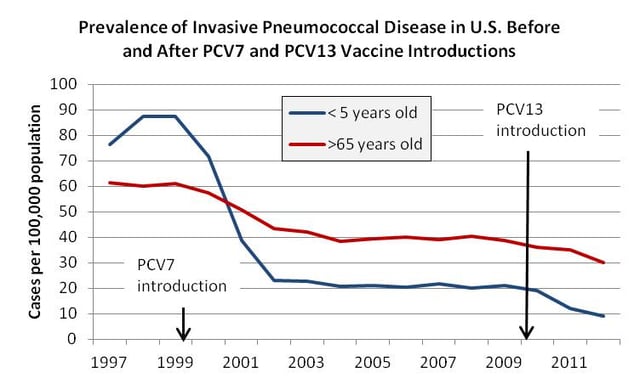
United States incidence of invasive pneumococcal disease before and after introduction of the 7-valent and 13-valent pneumococcal vaccines.[99]
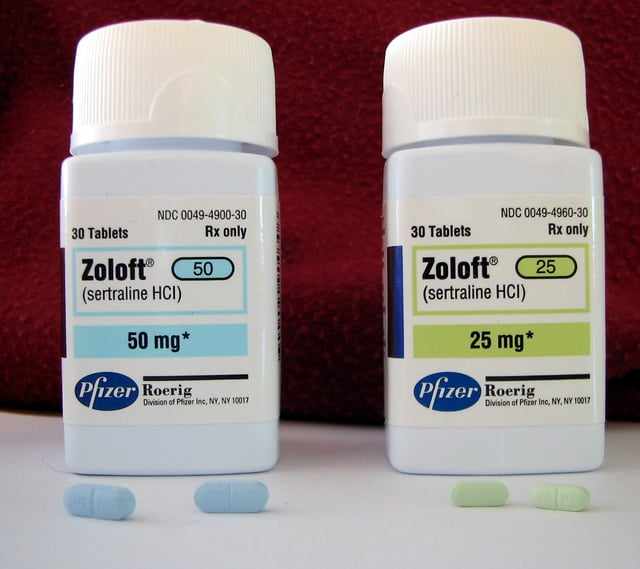
Bottles of the antidepressant Zoloft
Key current and Pfizer products include:
Prevnar (13-valent conjugate pneumococcal vaccine) is a vaccine for the prevention of invasive pneumococcal infections. The introduction of the original, 7-valent version of the vaccine in 1999 led to a 75% reduction in the incidence of invasive pneumococcal infections among children under age 5 in the United States. An improved version of the vaccine, providing coverage of 13 bacterial variants, was introduced in early 2010, and granted a patent in India in 2017. As of 2012 the rate of invasive infections among children under age 5 has been reduced by an additional 50%.[99]
Lyrica (pregabalin) for neuropathic pain. Sales of Lyrica were $4.6 billion in 2013; the US patent on Lyrica was challenged by generic manufacturers and was upheld in 2014, giving Pfizer exclusivity for Lyrica in the US until 2018.[100]
Xeljanz (tofacitinib) for rheumatoid arthritis and ulcerative colitis, which had sales of $1.77 billion in 2018 and in January 2019 it was top drug in the United States for direct-to-consumer advertising, passing Humira.[101]
Generics
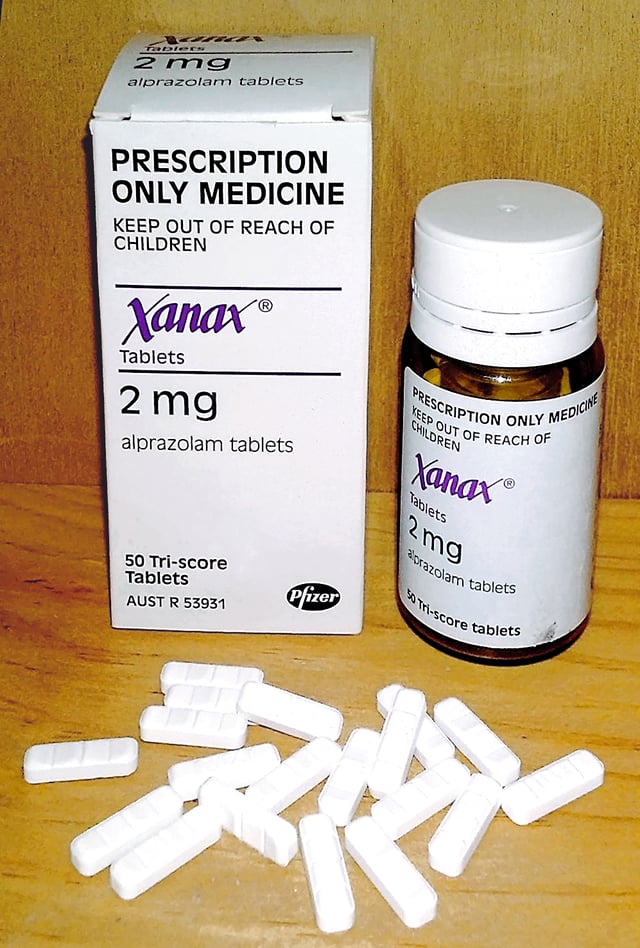
Xanax (alprazolam) 2 mg tri-score tablets
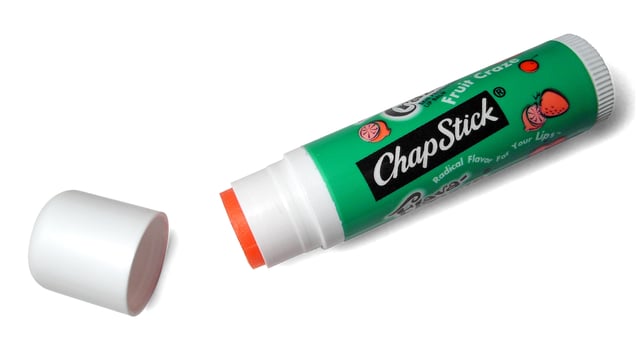
ChapStick
In addition to marketing branded pharmaceuticals, Pfizer is involved in the manufacture and sale of generics. In the US it does this through its Greenstone subsidiary, which it acquired as part of the acquisition of Pharmacia.[102] Pfizer also has a licensing deal in place with Aurobindo, which grants the former access to a variety of oral solid generic products.[103] Key historical generics include:
Atorvastatin (trade name Lipitor), a statin for the treatment of hypercholesterolemia. Lipitor was developed by Pfizer legacy company Parke-Davis, a subsidiary of Warner-Lambert and first marketed in 1996.[104] Although atorvastatin was the fifth drug in the class of statins to be developed, clinical trials showed that atorvastatin caused a more dramatic reduction in LDL-C than the other statin drugs. From 1996 to 2012 under the trade name Lipitor, atorvastatin became the world's best-selling drug of all time, with more than $125 billion in sales over approximately 14.5 years.[105] Lipitor alone "provided up to a quarter of Pfizer Inc.'s annual revenue for years."[105] The patent expired in 2011.[106]
Diflucan (fluconazole), the first orally available treatment for severe fungal infections. Fluconazole is recommended as a first-line treatment in invasive candidiasis[107] and is widely used in the prophylaxis of severe fungal infections in premature infants.[108] Fluconazole is on the World Health Organization's List of Essential Medicines.[109] Patent protection ended in 2004 and 2005.[110]
Flagyl (metronidazole) is a nitroimidazole antibiotic medication used particularly for anaerobic bacteria and protozoa. It is antibacterial against anaerobic organisms, an amoebicide, and an antiprotozoal.[111] As of 2018, it is second line for first episodes of mild-to-moderate Clostridium difficile infection (formerly was first-line).[112] It is on the World Health Organization's List of Essential Medicines.[109] The original patent protection ended in 1982, but reformulation evergreening occurred thereafter.[113]
Norvasc (amlodipine), an antihypertensive drug of the dihydropyridine calcium channel blocker class. Amlodipine is on the World Health Organization's List of Essential Medicines, a list of the most important medication needed in a basic health system.[109] Patent protection ended in 2007.[114]
Zithromax (azithromycin), a macrolide antibiotic that is recommended by the Infectious Disease Society of America as a first line treatment for certain cases of community-acquired pneumonia.[115] Patent protection ended in 2005.[116]
Zoloft (sertraline), is an antidepressant of the selective serotonin reuptake inhibitor (SSRI) class. It was introduced to the market by Pfizer in 1991. Sertraline is primarily prescribed for major depressive disorder in adult outpatients as well as obsessive–compulsive, panic, and social anxiety disorders in both adults and children. In 2011, it was the second-most prescribed antidepressant on the U.S. retail market, with 37 million prescriptions.[117] The patent expired 2006.[118]
Promotional practices
Pfizer has long been known within the industry as one of the more aggressive marketers of their products.[119] [120][121]Access to Wyeth internal documents has revealed marketing strategies used to promote Neurontin for off-label use.[122] In 1993, the U.S. Food and Drug Administration (FDA) approved gabapentin (Neurontin, Pfizer) only for treatment of seizures. Warner–Lambert, which merged with Pfizer in 2000, used activities not usually associated with sales promotion, including continuing medical education and research, sponsored articles about the drug for the medical literature, and alleged suppression of unfavorable study results, to promote gabapentin. Within 5 years the drug was being widely used for the off-label treatment of pain and psychiatric conditions. Warner–Lambert admitted to charges that it violated FDA regulations by promoting the drug for pain, psychiatric conditions, migraine, and other unapproved uses, and paid $430 million to resolve criminal and civil health care liability charges.[123][124] A recent Cochrane review concluded that gabapentin is ineffective in migraine prophylaxis.[125] The American Academy of Neurology rates it as having unproven efficacy, while the Canadian Headache Society and the European Federation of Neurological Societies rate its use as being supported by moderate and low-quality evidence, respectively.[126]
In September 2009, Pfizer agreed to pay $2.3 billion to settle civil and criminal allegations that it had illegally marketed four drugs—Bextra, Geodon, Zyvox, and Lyrica—for non-approved uses; it was Pfizer's fourth such settlement in a decade.[127][128][129] The payment included $1.3 billion in criminal penalties for felony violations of the Food, Drug and Cosmetic Act, and $1 billion to settle allegations it had illegally promoted the drugs for uses that were not approved by the U.S. Food and Drug Administration (FDA) and caused false claims to be submitted to Federal and State programs. The criminal fine was the largest ever assessed in the United States up to that time.[130] Pfizer has entered an extensive corporate integrity agreement with the Office of Inspector General and will be required to make substantial structural reforms within the company, and maintain the Pfizer website (www.pfizer.com/pmc) to track the company's post marketing commitments. Pfizer had to also put a searchable database of all payments to physicians the company had made on the Pfizer website by March 31, 2010.[131]
Peter Rost was vice president in charge of the endocrinology division at Pharmacia before and during its acquisition by Pfizer. During that time he raised concerns internally about kickbacks and off-label marketing of Genotropin, Pharmacia's human growth hormone drug. Pfizer reported the Pharmacia marketing practices to the FDA and Department of Justice; Rost was unaware of this and filed an FCA lawsuit against Pfizer. Pfizer kept him on, but isolated him until the FCA suit was unsealed in 2005. The Justice Department declined to intervene, and Pfizer fired him, and he filed a wrongful termination suit against Pfizer.[132] Pfizer won a summary dismissal of the case, with the court ruling that the evidence showed Pfizer had decided to fire Rost prior to learning of his whistleblower activities.[133]
A "whistleblower suit" was filed in 2005 against Wyeth, which was acquired by Pfizer in 2009, alleging that the company illegally marketed their drug Rapamune. Wyeth is targeted in the suit for off-label marketing, targeting specific doctors and medical facilities to increase sales of Rapamune, trying to get current transplant patients to change from their current transplant drugs to Rapamune and for specifically targeting African-Americans. According to the whistleblowers, Wyeth also provided doctors and hospitals with kickbacks to prescribe the drug in the form of grants, donations and other money.[134][135] In 2013, the company pleaded guilty to criminal mis-branding violations under the Food, Drug and Cosmetic Act. By August 2014 it had paid $491 million in civil and criminal penalties.[136]
According to Harper's Magazine publisher John MacArthur, Pfizer withdrew "between $400,000 and a million dollars" worth of ads from their magazine following an unflattering article on depression medication.[137]
Litigation
Quigley Co.
Pfizer acquired Quigley in 1968, and the division sold asbestos-containing insulation products until the early 1970s.[138] Asbestos victims and Pfizer have been negotiating a settlement deal that calls for Pfizer to pay $430 million to 80 percent of existing plaintiffs. It will also place an additional $535 million into an asbestos settlement trust that will compensate future plaintiffs as well as the remaining 20 percent of current plaintiffs with claims against Pfizer and Quigley. The compensation deal is worth $965 million all up. Of that $535 million, $405 million is in a 40-year note from Pfizer, while $100 million will come from insurance policies.
Bjork–Shiley heart valve
Pfizer purchased Shiley in 1979 at the onset of its Convexo-Concave valve ordeal, involving the Bjork–Shiley heart valve. Approximately 500 people died when defective valves failed and, in 1994, the United States ruled against Pfizer for ~$200 million.[139][140]
Abdullahi v. Pfizer, Inc and Trovafloxacin (Trovan) Controversy.
In 1996, an outbreak of measles, cholera, and bacterial meningitis occurred in Nigeria. Pfizer representatives and personnel from a contract research organization (CRO) traveled to Kano, Nigeria to set up a clinical trial and administer an experimental antibiotic, trovafloxacin, to approximately 200 children.[141] Local Kano officials report that more than 50 children died in the experiment, while many others developed mental and physical deformities.[142] The nature and frequency of both fatalities and other adverse outcomes were similar to those historically found among pediatric patients treated for meningitis in sub-Saharan Africa.[143] In 2001, families of the children, as well as the governments of Kano and Nigeria, filed lawsuits regarding the treatment.[144] According to the news program Democracy Now!, "[r]esearchers did not obtain signed consent forms, and medical personnel said Pfizer did not tell parents their children were getting the experimental drug."[145] The lawsuits also accuse Pfizer of using the outbreak to perform unapproved human testing, as well as allegedly under-dosing a control group being treated with traditional antibiotics in order to skew the results of the trial in favor of Trovan. While the specific facts of the case remain in dispute, both Nigerian medical personnel and at least one Pfizer physician have stated that the trial was conducted without regulatory approval.[146][147]
In 2007, Pfizer published a Statement of Defense letter.[148] The letter states that the drug's oral form was safer and easier to administer, that Trovan had been used safely in over 5000 Americans prior to the Nigerian trial, that mortality in the patients treated by Pfizer was lower than that observed historically in African meningitis epidemics, and that no unusual side effects, unrelated to meningitis, were observed after 4 weeks.
In June 2010, the US Supreme Court rejected Pfizer's appeal against a ruling allowing lawsuits by the Nigerian families to proceed.[149]
In December 2010, WikiLeaks released US diplomatic cables, which indicate that Pfizer had hired investigators to find evidence of corruption against Nigerian attorney general Aondoakaa to persuade him to drop legal action.[150] Washington Post reporter Joe Stephens, who helped break the story in 2000, called these actions "dangerously close to blackmail."[145] In response, the company has released a press statement describing the allegations as "preposterous" and stating that they acted in good faith.[151] Aondoakka, who had allegedly demanded bribes from Pfizer in return for a settlement of the case,[152] was declared unfit for office and had his U.S. visa revoked in association with corruption charges in 2010.[153][154]
Retrovirus lawsuit
A scientist claims she was infected by a genetically modified virus while working for Pfizer. In her federal lawsuit she says she has been intermittently paralyzed by the Pfizer-designed virus. "McClain, of Deep River, suspects she was inadvertently exposed, through work by a former Pfizer colleague in 2002 or 2003, to an engineered form of the lentivirus, a virus similar to the one that can lead to acquired immune deficiency syndrome, also known as AIDS."[155] The court found that McClain failed to demonstrate that her illness was caused by exposure to the lentivirus,[156] but also that Pfizer violated whistleblower laws.[157]
Blue Cross Blue Shield
Health insurance company Blue Cross Blue Shield (BCBS) filed a lawsuit against Pfizer for reportedly illegally marketing their drugs Bextra, Geodon and Lyrica. BCBS is reporting that Pfizer used "kickbacks" and wrongly persuaded doctors to prescribe the drugs.[158][159] FiercePharma reported that "According to the suit, the drugmaker not only handed out those "misleading" materials on off-label uses, but sent doctors on Caribbean junkets and paid them $2,000 honoraria in return for their listening to lectures about Bextra. More than 5,000 healthcare professionals were entertained at meetings in Bahamas, Virgin Islands, and across the U.S., the suit alleges."[160][161] The case was settled in 2014 for $325M.[162]
Brigham Young University
Controversy arose over the drug "Celebrex". Brigham Young University (BYU) said that a professor of chemistry, Dr. Daniel L. Simmons, discovered an enzyme in the 1990s that would later lead towards the development of Celebrex. BYU was originally seeking 15% royalty on sales, which would equate to $9.7 billion. The court filings show that a research agreement was made with Monsanto, whose pharmaceutical business was later acquired by Pfizer, to develop a better aspirin. The enzyme that Dr. Simmons claims to have discovered would induce pain and inflammation while causing gastrointestinal problems, which Celebrex is used to reduce those issues. A battle ensued, lasting over six years, because BYU claimed that Pfizer did not give him credit or compensation while Pfizer claims it had met all obligations regarding the Monsanto agreement. This culminated in a $450 million amicable settlement without going to trial. Pfizer said it would take a $450 million charge against first quarter earnings to settle.[163]
Litigation in which Pfizer was not a party
Pfizer was discussed as part of the Kelo v. New London case that was decided by U.S. Supreme Court in 2005. In February 1998 Pfizer announced it would build a research facility in New London, Connecticut, and local planners, hoping to promote economic development and build on the influx of jobs the planned facility would bring to the town, created a plan that included seizing property to redevelop it under eminent domain, and local residents sued to stop the seizure. The case went to the Supreme Court, and with regard to Pfizer, the court cited a prior decision that said: "The record clearly demonstrates that the development plan was not intended to serve the interests of Pfizer, Inc., or any other private entity, but rather, to revitalize the local economy by creating temporary and permanent jobs, generating a significant increase in tax revenue, encouraging spin-off economic activities and maximizing public access to the waterfront”.[164] The Supreme Court allowed the eminent domain to proceed.[164] Pfizer opened the facility in 2001 but abandoned it in 2009, angering residents of the town.[165]
Environmental record
Between 2002 and 2008, Pfizer reduced its greenhouse emissions by 20%,[166] and committed to reducing emissions by an additional 20% by 2012. In 2012 the company was named to the Carbon Disclosure Project's Carbon Leadership Index in recognition of its efforts to reduced greenhouse gas emissions.[167]
Pfizer has inherited Wyeth's liabilities in the American Cyanamid site in Bridgewater, New Jersey. This site is highly toxic and an EPA declared Superfund site. Pfizer has since attempted to remediate this land in order to clean and develop it for future profits and potential public uses.[168] The Sierra Club and the Edison Wetlands Association have come out in opposition to the cleanup plan, arguing that the area is subject to flooding, which could cause pollutants to leach. The EPA considers the plan the most reasonable from considerations of safety and cost-effectiveness, arguing that an alternative plan involving trucking contaminated soil off site could expose cleanup workers. The EPA's position is backed by the environmental watchdog group CRISIS.[169]
In June 2002, a chemical explosion at the Groton plant injured seven people and caused the evacuation of over 100 homes in the surrounding area.[170]
Political lobbying
Pfizer is a leading member of the U.S. Global Leadership Coalition, a Washington D.C.-based coalition of over 400 major companies and NGOs that advocates for a larger International Affairs Budget, which funds American diplomatic, humanitarian, and development efforts abroad.[171]
Pfizer is one of the single largest lobbying interests in United States politics. For example, in the first 9 months of 2009 Pfizer spent over $16.3 million on lobbying US congressional lawmakers, making them the sixth largest lobbying interest in the US (following Pharmaceutical Research and Manufacturers of America (PhRMA), which ranked fourth but also represents many of their interests). A spokeswoman for Pfizer said the company “wanted to make sure our voice is heard in this conversation” in regards to the company's expenditure of $25 million in 2010 to lobby health care reform.[172]
According to U.S. State Department cables released by the whistleblower site WikiLeaks, Pfizer "lobbied against New Zealand getting a free trade agreement with the United States because it objected to New Zealand's restrictive drug buying rules and tried to get rid of New Zealand's former health minister, Helen Clark, in 1990.[173]
In an example of the revolving door between government and industry in the United States, Scott Gotlieb, who resigned as the US FDA Commissioner in April 2019, joined the Pfizer board of directors three months later, in July.[174]
Employment and diversity
Since 2004, Pfizer has received a 100% rating every year on the Corporate Equality Index, released by the Human Rights Campaign Foundation.
In 2012, Pfizer's Canadian division, which then employed 2,890 people, was named one of Montreal's Top 15 Employers, the only research-based pharmaceutical company to receive this honor.[175]
Involvement in developing world health issues
Pfizer makes the anti-fungal drug fluconazole available free of charge to governmental and non-governmental organizations (NGOs) in developing countries with a greater than 1% prevalence of HIV/AIDS.[176][177][178] The company has also pledged to provide up to 740 million doses of its anti-pneumococcal vaccine at discounted rates to infants and young children in 41 developing countries in association with the GAVI Alliance.[179]
In 2012, Pfizer and the Gates Foundation announced a joint effort to provide affordable access to Pfizer's long-lasting injectable contraceptive, medroxyprogesterone acetate, to three million women in developing countries.[180]
See also
Biotech and pharmaceutical companies in the New York metropolitan area
Companies of the United States with untaxed profits
Fire in the Blood (2013 film)
List of pharmaceutical companies